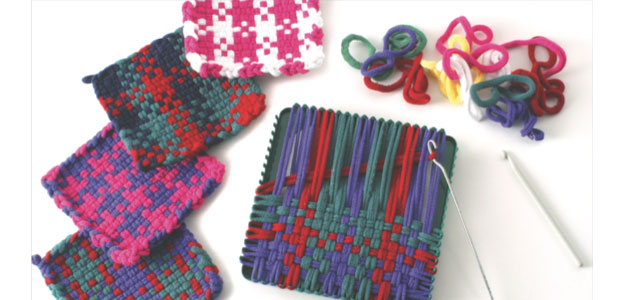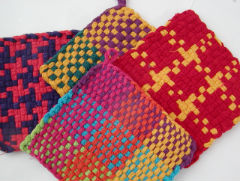From Socks to Potholders: a Favorite Craft Makes a Comeback
 Nearly every kitchen in America has at least one potholder woven from colored loops. It may have been a gift from a child, grandchild or favorite nephew. It may even be something you made yourself when you were eight years old.
Nearly every kitchen in America has at least one potholder woven from colored loops. It may have been a gift from a child, grandchild or favorite nephew. It may even be something you made yourself when you were eight years old.
The ubiquitous woven potholder has an unexpected history – one that seems especially relevant with today’s return to frugality and renewed interest in recycling. Potholder loops were originally a waste product from sock manufacturing, a big industry in the US in the 1930’s. During the Great Depression, the extra loops of fabric removed from sock tubes were recycled to housewives, and a square peg loom was developed for making potholders and hotpads.
By the 1950s, woven potholders had become a favorite American craft, inexpensive and accessible to everyone. Children as young as five could begin to finger weave on a peg loom. Because the potholders were useful in the kitchen, nearly every household with a child had its own production company.
However, potholder weaving had its challenges. Color selection was limited, loop sizes were as varied as the sizes of socks being made, and the thickness of the loops varied by type of yarn being used for the socks. Many loops didn’t actually fit on the loom, a source of much frustration to the weaver.
By the late 1900’s, potholder loops were becoming more and more difficult to find. Sock manufacturing had been sent to overseas factories. Some toy companies began importing nylon loops, but nylon potholders won’t stand up to actual use in the kitchen – they’ll melt!
 In response, Harrisville Designs, a weaving company in New Hampshire, began manufacturing cotton loops specifically for making potholders. The new loops are sized correctly for the loom, and are made in a wide palette of vivid colors. The square metal potholder loom itself underwent some improvements, with pegs angled outward so that the loops stayed on better.
In response, Harrisville Designs, a weaving company in New Hampshire, began manufacturing cotton loops specifically for making potholders. The new loops are sized correctly for the loom, and are made in a wide palette of vivid colors. The square metal potholder loom itself underwent some improvements, with pegs angled outward so that the loops stayed on better.
Now potholder weaving is more popular than ever – and not just for kids. Most adults remember making potholders, and many are inspired to weave them again when they see the selection of colors and creative patterns for weaving. Some do-it-yourselfers have even returned to tradition by cutting up their worn or mismatched socks to be used again as potholder loops.
Artbeat online, USA

PROFILE
A store and studio in Arlington, Massachusetts, serving families and friends in the Boston metropolitan area.
The folks at ARTBEAT are proud to say they’re creative dabblers.
They find inspiration by getting their hands on anything and turning it into something. They find fun in knowing that there are infinite possibilities, and that given the same materials, each of us will create something different.
